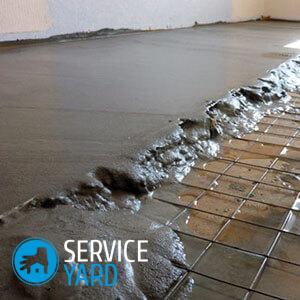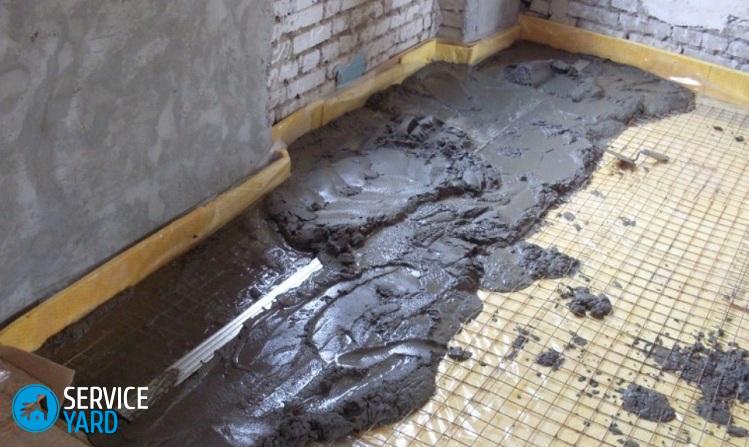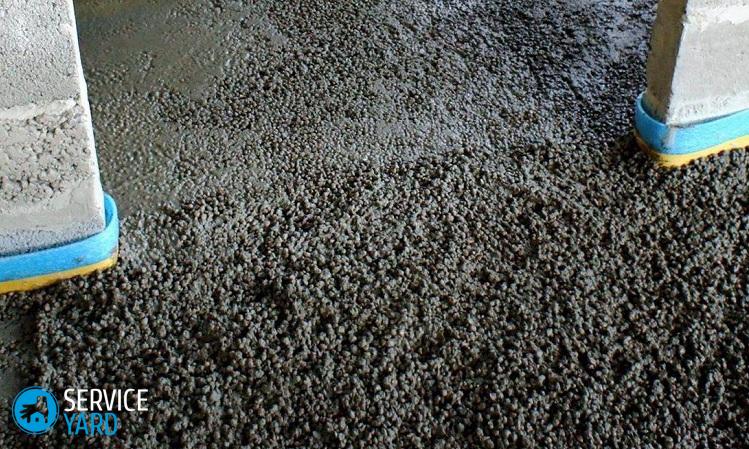Screed reinforcement

Despite the huge variety of advantages, concrete is a rather fragile material, which is the main reason for premature wear of the floor screed. Effectively solve this problem allows a method such as reinforcing screeds. It plays a significant role in the construction of the subfloor, because it is thanks to the reinforcing layer that you can achieve the desired strength, as well as reduce the risk of destruction in case of shrinkage of the entire structure. Therefore, if you decide to strengthen the screed with reinforcement, we will tell you how to do it correctly, what materials are suitable for these purposes.
to contents ↑When is reinforcement necessary?
Most often, floor screed is performed without a reinforcing layer. Nevertheless, there are situations in which you cannot do without it. These include:
- Laying multi-layer screed with thermal insulation;
- Laying a rough screed;
- In rooms where a large load is expected with a leveling screed;
- When arranging “warm” floors;
- Laying thin screeds.
Benefits of Reinforcement
Despite the fact that the usual screed and reinforced, in fact, do not differ from each other, nevertheless - these are two completely different types of subfloors. Their main difference is the presence of an additional layer - the grid. In this regard, the installation and operational characteristics of such a floor are also different. For example, on a curved floor, laying concrete in the second case will be much easier than in the usual way.
In addition, reinforcing the screed with a reinforcing layer also has such advantages:
- Increased floor performance;
- Reduced risk of cracking
- Increase in strength;
- Reducing the thickness of the screed layer;
- Increases resistance to various factors;
- Saving building materials, such as mortar;
- Ease of work;
- The ability to quickly cope with various deformations and uneven floors.
Materials used for reinforcement
To strengthen the screed, special meshes with certain characteristics and parameters are used. The mesh for screed can be made of metal, polymeric materials, fiberglass or fiber. Further in more detail we will tell you about each of these types.
Important! Pay attention to the fact that the grid designed for floor screed has cells of exclusively square shape.
Metal mesh
This type of mesh is made of durable steel wire with a diameter of 2.5-6 millimeters. The cell size of such material varies in the range of 6-20 centimeters.
Important! When choosing a metal reinforcing mesh for the screed, one should take into account the fact that the strength of the mesh itself directly depends on the size of the cells - the larger they are, the lower its strength indicators.
Metal nets with a small thickness of wire are delivered to stores in the form of rolls, which greatly facilitates their transportation. The width of such a roll is 1-1.5 meters, and the length is 25 meters. The main advantages of this reinforcing material include:
- High tensile strength;
- Reliability;
- Resistance to temperature extremes;
- Long service life;
- Good bonding ability.
Using a metal mesh to reinforce the screed, the risk of cracking in this case is extremely low.This is due to the fact that the wire takes on absolutely all types of stress, thereby ensuring the safety of the screed, due to which the bearing capacity of the floor becomes much larger.
Important! Pay attention to the fact that the metal mesh is laid in the lower layers of the screed so that it is inside it. To do this, you need to raise the mesh above the base, using special stands to help you.
Plastic nets
If you are going to reinforce a screed with a thickness of about 8 centimeters, in this case the floor will not experience excessive loads, respectively - the use of metal grids is impractical. Best in such a situation is a plastic or polypropylene reinforcing mesh. In relation to metal, it is a rather light, soft and elastic material. Due to this, the mesh is easily stretched and not deformed.
Important! Plastic material is much weaker than metal, so it is not practical to use it if a large load is applied to the floor.
Most often, for screed use a conventional building mesh, which is implemented in rolls. The width of such a package can vary in the range of 1-4 meters, and the length is 50 meters.
The main advantage of this material is the ease of working with it. For example, in order to cut such a grid into pieces, unlike a metal one, you can use ordinary scissors without involving outside help.
Important! Pay attention to the fact that, unlike other materials, plastic nets do not rot and do not rust, which positively affects the further performance characteristics of the screed.
The main advantages of reinforcing screeds using a polymer mesh include the following:
- Flexibility and elasticity;
- Does not interfere with the operation of household appliances;
- Inertness in relation to various chemicals;
- Lightness of material;
- Resistance to stretching and deformation;
- Easy installation.
Fiberglass mesh
This reinforcing material is made of special glass - aluminoborosilicate. Such a grid has a standard mesh size, which is 6 millimeters.
Important! Some types of fiberglass reinforcing material are impregnated with special substances that significantly increase the resistance of the mesh itself to various alkaline substances.
Fiberglass reinforcing material is sold in the form of rolls that are lightweight, so that transportation problems do not arise. In terms of performance, a fiberglass reinforcing mesh is equivalent to plastic.
Fiber reinforcement
Fiber is a small fiber, the length of which varies from 6-20 millimeters.
Important! Very rarely can be found on sale fiber fibers with a length of 50-60 millimeters. Basically, this material is made of metal.
To date, the following types of fiber are used to reinforce floor screed:
- Basaltic. This material is used if in the future the surface will be exposed to strong chemicals, as well as various atmospheric precipitation.
- Polypropylene or glass. In this case, the finished result will come out easy enough for you. However, such floors are not intended to be subjected to heavy loads.
- Metal. These fibers are used in the event that a strong load will occur on the screed.
The main advantage of fiber fibers is that with their help it is possible to protect the screed from the appearance of cracks on it, even after the concrete mortar has completely dried. Unfortunately, this material is not able to withstand mechanical stresses, including bending and stretching.
to contents ↑Important! Fiber screed reinforcement is significantly different from the technology used in the mesh situation.In this case, the fiber is mixed directly into the solution itself.
Reinforcement Process Technology
After you have selected and purchased the necessary material, you should prepare in advance the tools that will be needed in the process of reinforcing the floor screed with a mesh. You will need:
- Construction marker;
- Rules;
- Knife;
- Level;
- Roller;
- Roulette.
Now you first need to prepare the floor itself. The work sequence consists of the following stages:
- Clean the subfloor from old flooring and debris.
- Treat the rough surface with an antiseptic.
- Put a layer of waterproofing.
- On the walls, mark the floor zero.
- Focusing on the upper marks around the entire perimeter, place the beacons.
After the necessary equipment has been purchased and the preparatory work has been completed, you can proceed directly to the process of reinforcing the screed. You need to do this in this order:
- Place the grid supports on the prepared surface. Spread the reinforcing material of your choice on them.
Important! Please note that the mesh must not come into contact with the subfloor.
- Concrete the rough surface. To do this, the solution must be poured between the beacons, while starting should be from the corner, which is located at the farthest distance from the front door.
- Level the surface using the rule. Leave the screed alone for about thirty minutes.
- Scratch the surface of the screed and leave for several days until it dries completely.
Important! So that the concrete does not crack upon drying, it must be periodically sprayed with water.
- After a week after laying the solution, remove the beacons, and close the cracks.
Useful Tips
In order for the installation and reinforcement of the screed to proceed quickly and without complications, we recommend that you take into account several nuances during operation:
- The thickness of the reinforced screed should be at least 6 centimeters.
- The full drying time of the concrete mortar is 28 days, so you should not touch it all this time for further work.
- If you are screeding in the spring and summer, after pouring the floor you need to cover it with plastic wrap.
- The mesh must be completely covered with concrete.
Stock footage
Reinforcing screeds is a great way to equip a reliable and durable subfloor, on which you can later easily lay a finish layer. We hope that our article and tips will help you at all stages of this process so that you are ultimately calm about the integrity of the screed layer.
- How to choose a vacuum cleaner taking into account the characteristics of the house and coatings?
- What to look for when choosing a water delivery
- How to quickly create comfort at home - tips for housewives
- How to choose the perfect TV - useful tips
- What to look for when choosing blinds
- What should be running shoes?
- What useful things can you buy in a hardware store
- Iphone 11 pro max review
- Than iPhone is better than Android smartphones





